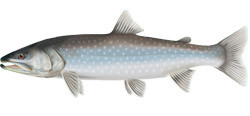
The Fish Sustainability Index (FSI) combines scientific and local knowledge to assess the health of Bull Trout in Alberta.
Bull Trout FSI Maps
Adult Density (Current and Historic)
- Current Adult Density Fish Sustainability (FSI) Rankings for Bull Trout
- Historic Adult Density Fish Sustainability (FSI) Rankings for Bull Trout
Please note that data reliability is not currently displayed in these figures.
Habitat and Overharvest Protection Needs
- Habitat Protection Needs Fish Sustainability (FSI) Rankings for Bull Trout, 2013
- Overharvest Protection Needs Fish Sustainability (FSI) rankings for Bull Trout, 2013
Please note that data reliability is not currently displayed in these figures.
The complete FSI spatial data layers can be viewed and downloaded in:
Bull Trout Population Status
In summary, Bull Trout have shown serious declines, range contractions, and lost populations. In spite of nearly two decades of harvest protection, healthy or recovered populations are found primarily in protected landscapes such as national and provincial parks. Although controlling fishing pressure is important, conserving Bull Trout will require more effective management of land use in key watersheds.
Historically, Bull Trout were abundant in at least 60 mountain and foothill watersheds in Alberta, with large fish reported downstream of the mountains and foothills in most major Alberta rivers.
Several watersheds on the fringe of the core Bull Trout ranges in the foothills may have held Bull Trout, but likely at low densities or as intermittent populations as natural conditions of warm water or inconsistent groundwater were likely limiting.
As of 2014, Bull Trout populations in only 7 watersheds (all in national or provincial parks) were assessed as healthy (adult density was ranked as low risk). The populations of Bull Trout in 20 watersheds have been lost, as well as those portions of populations that seasonally occupied the lower mainstems of the Peace, Athabasca, North Saskatchewan, Red Deer, and Bow rivers.
The majority of Bull Trout watersheds were assessed as having either low or very low abundance of adult fish, with the lowest densities assessed in the most heavily developed watersheds.
Monitoring of Bull Trout has focussed on relatively few, high-profile watersheds, and a more consistent and widespread monitoring program is required.
Threats to Sustainability
The main threats to sustainability of Bull Trout were noted as:
- Heavy land use and development including forestry, oil and gas, agriculture, and urbanization are associated with poor Bull Trout status. Changes to surface and groundwater flow, stream fragmentation, and loss of riparian cover may be causes of declines and failures of recovery.
- Improved road and off-road vehicle access and increasing sport fishing (even at catch-and-release) may continue to threaten Bull Trout sustainability, although catch-and-release has shown success in recovering Bull Trout in the protected landscapes of parks.
- Increasing summer temperatures will reduce available Bull Trout stream habitat. Unusual weather events (e.g., floods, summer heat waves and droughts) may result in local summerkills and loss of flows for the following winter.
Next Steps
- Bull Trout monitoring must be standardised and expanded to encompass the species' range in Alberta to improve our understanding of current population characteristics and how they may change following alterations in management strategies and/or land use.
- Land use planning and management must include Bull Trout as an important and valued ecosystem component. Modelling and monitoring of Bull Trout and their habitat requirements should remain a key feature of foothills Landuse Framework planning.
- Bull Trout in protected headwaters areas (national and provincial parks) should be managed for high abundance in order to provide natural recolonization of lost, downstream populations and as resilience against future losses from changing climate.
- Completing conservation and management actions identified in the Bull Trout Conservation Management Plan should remain a high priority for resource managers.